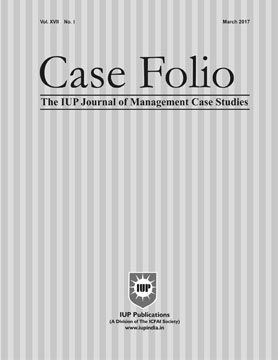
Mar '21
The IUP Journal of Case Folio
Archives
Taiwan: A Global Model for Combatting the Covid-19 Crisis
Syeda Maseeha Qumer
Adjunct Research Faculty, IBS Case Research Center, IBS Hyderabad (Under IFHE ? A Deemed
to be University u/s 3 of the UGC Act, 1956), Hyderabad, Telangana, India.
E-mail: maseeha@icmrindia.org
The case discusses the measures taken by the Taiwanese government to tackle the COVID-19 crisis. Despite its close geographic proximity to China, where the outbreakbegan, Taiwan had limited its cases to just 443 as of May 30, 2020, with only seven deaths. Taiwan with its speedy,efficient, and expert-led response, has thus become a role model in combating thepandemic globally, despite its exclusion from the World Health Organization(WHO). The case highlights the lessons the world could learn from Taiwan?s successful response to the COVID-19 crisis, particularly the ?5 Ts?: transparency, transportation controls,tracking, testing, and technology. After its success in containing the coronavirus outbreak, analysts wondered whether Taiwan would be invited to join the WHO so that the global community would get more opportunities to learn about the country?s epidemic prevention model and healthcare expertise. Also, it remained to be seen whether Taiwan would be able to maintain its robust pandemic prevention policies until the end of the pandemic. .
Through early recognition of the crisis, daily briefings to the public, and simple health messaging, the government was able to reassure the public by delivering timely, accurate, and transparent information regarding the evolving epidemic. Taiwan is an example of how a society can respond quickly to a crisis and protect the interests of its citizens.i
- C Jason Wang, Director of Center for Policy, Outcomes and Prevention at Stanford Medicine, in March 2020.
Introduction
While countries across the globe were grappling with the Coronavirus Disease
(Covid-19) crisis due to large-scale infections and deaths, one nation managed to effectively flatten the curve and slow down the spread of infection?Taiwan. As of May 30, 2020, Taiwan had registered about 443 coronavirus cases and reported 7 deaths, according to data from Johns Hopkins University.1 The figures were among the lowest in the world despite the country?s close geographic proximity to mainland China, where the disease originated in December 2019. Early intervention and the vigilant monitoring undertaken by the Taiwanese government to curb the spread of the virus earned it accolades and recognition as one of the best pandemic responses worldwide. Experts praised Taiwan for its early, speedy, efficient, and expert-led response to the pandemic, despite its being excluded from the World Health Organization (WHO).2 ?Taiwan?s ability to contain the #COVID19 outbreak is a tribute to our unity and resilience. It also speaks to the collaboration between our government, people, and many private businesses that have ramped up production to protect public health and make the impossible possible,?ii said Tsai Ing-wen (President Tsai), President of Taiwan.
As the coronavirus spread in China, there were forecasts that Taiwan would be heavily hit in part because of its proximity to China, regular flights going from the island to China each day, and many Taiwanese citizens working in China. However, Taiwan learned from its mistakes during the 2003 SARS experience and put in place a public health emergency response mechanism that enabled experienced officials to quickly recognize the crisis at hand and strengthen its all-round response capacity. Taiwanese authorities went into action as soon as they learnt of pneumonia cases of unknown cause in the Chinese city of Wuhan in December 2019. Early measures included a travel ban from parts of China, case identification, containment, rapid isolation, aggressive testing, massive production of masks to protect public health, and transparent communication. In addition, the Taiwanese government promoted precautionary measures like social distancing and wearing of face masks in public and introduced stringent punishments for violators of quarantine orders. Analysts attributed Taiwan?s success largely to the use of big data, advanced analytics, and new technologies, from case tracing mechanisms to mask availability apps. As part of the ?Taiwan can help? campaign, the Taiwanese government donated about 17 million face masks to countries hit hardest by Covid-19 and offered to share its knowledge and experience with the world in tackling the crisis. However, the biggest challenge for Taiwan in its epidemic response was its exclusion from the WHO due to diplomatic isolation by China, which shut it off from receiving crucial and timely information related to the crisis.
Taiwan?s success in controlling Covid-19 bolstered its global image. Led by the US, a growing number of countries began expressing their support for Taiwan to be either included as a member of the WHO, or to be given observer status. According to them, Taiwan, had emerged as a global model for combatting Covid-19, and countries globally would benefit from more opportunities to learn about its epidemic prevention model and its healthcare expertise if it were to be a part of the WHO. Keen to share its experiences in fighting Covid-19, Taiwan too pushed for a greater voice in global health discussions. According to President Tsai, ?Indeed, Taiwan has effectively managed the containment of the coronavirus within our borders. Yet on a global level, Covid-19 is a humanitarian disaster that requires the joint efforts of all countries. Although Taiwan has been unfairly excluded from the WHO and the UN, we remain willing and able to utilize our strengths across manufacturing, medicine and technology to work with the world.?iii
About Taiwan
Taiwan, officially called the Republic of China, is an island state in East Asia, about 180 km off the coast of mainland China. The total area of Taiwan is around 36,197 square kilometers and the country has a population of 23.59 million (2018). About 850,000 to 1 million of its citizens live or work in China. Numerous daily flights link the island to multiple major cities in China. Taiwan is a self-governing democratic republic whose head of state is the president.
China had been claiming Taiwan as part of its territory since the end of the Chinese civil war in 1949. It had largely blocked Taiwan from participating in many international organizations such as the United Nations (UN) unless it accepted the ?One China?3 principle.
As WHO membership was given only to countries that were members of the UN, Taiwan was excluded from the WHO as it was not a full member of the UN. Between 2009 and 2016, Beijing allowed Taiwan to attend the annual World Health Assembly (WHA) as an observer under the name ?Chinese Taipei?. That changed, however, with the election of President Tsai in 2016. President Tsai belonged to the Democratic Progressive Party that viewed Taiwan as a de facto independent nation and did not agree with Beijing?s idea that it belonged to China.iv Thereafter, Taiwan was deprived of its ?observer status?v and was barred from attending the annual WHA.
Taiwan had led a decades-long campaign for inclusion in the WHO, arguing that its highly-regarded healthcare system should earn it a place in the world?s public health agency. But despite these efforts, Taiwan was effectively locked out of membership in the WHO due to its complicated relationship with China.
Outbreak of Covid-19
The coronavirus outbreak came to light on December 31, 2019, when China informed the WHO of a cluster of cases of pneumonia of unknown cause in Wuhan City in Hubei Province, China?the seventh-largest city in China with 11 million residents. The first reported infected individuals were discovered to be stallholders in the Wuhan South China Seafood Market. Subsequently, the wet market was closed on January 1, 2020.
The virus causing the outbreak was determined to be a novel coronavirus, namely SARS-CoV-2, a betacoronavirus related to the Middle Eastern Respiratory Syndrome virus (MERS-CoV) and the Severe Acute Respiratory Syndrome virus (SARSCoV). The name ?coronavirus? came due to the crown-like projections on their surfaces (?Corona? in Latin means ?halo? or ?crown?). The virus was highly contagious and it spread rapidly and continuously evolved in the human population. SARS-CoV-2 was believed to be a spillover of an animal coronavirus that later adapted itself to enable human-to-human transmission. The coronavirus disease was a respiratory illness that spread largely through droplets in the air which were expelled when an infected person coughed or sneezed. Common signs of the infection included respiratory symptoms, fever, cough, shortness of breath, and breathing difficulties. In more severe cases, the infection could cause pneumonia, severe acute respiratory syndrome, kidney failure, and even death. There was no specific vaccine or treatment for the disease. However, there were many ongoing clinical trials evaluating potential treatments.
Subsequently, the disease spread to more provinces in China, and to the rest of the world. On January 13, 2020, Thailand reported the first international case outside China, while the first case within China, but outside Wuhan was reported on January 19, 2020 in Guangdong and Beijing. The outbreak was declared a Public Health Emergency of International Concern by WHO on January 30, 2020. On February 11, 2020, the WHO announced a name for the new coronavirus disease?Covid-19. Finally, on March 11, 2020, it officially declared the outbreak of Covid-19 a pandemic, after the disease had spread to more than 100 countries and led to tens of thousands of cases within a few months. As of June 24, 2020, global infections from Covid-19 stood at 9.4 million with deaths at 480,095 according to reference website Worldometer (See Exhibit I).
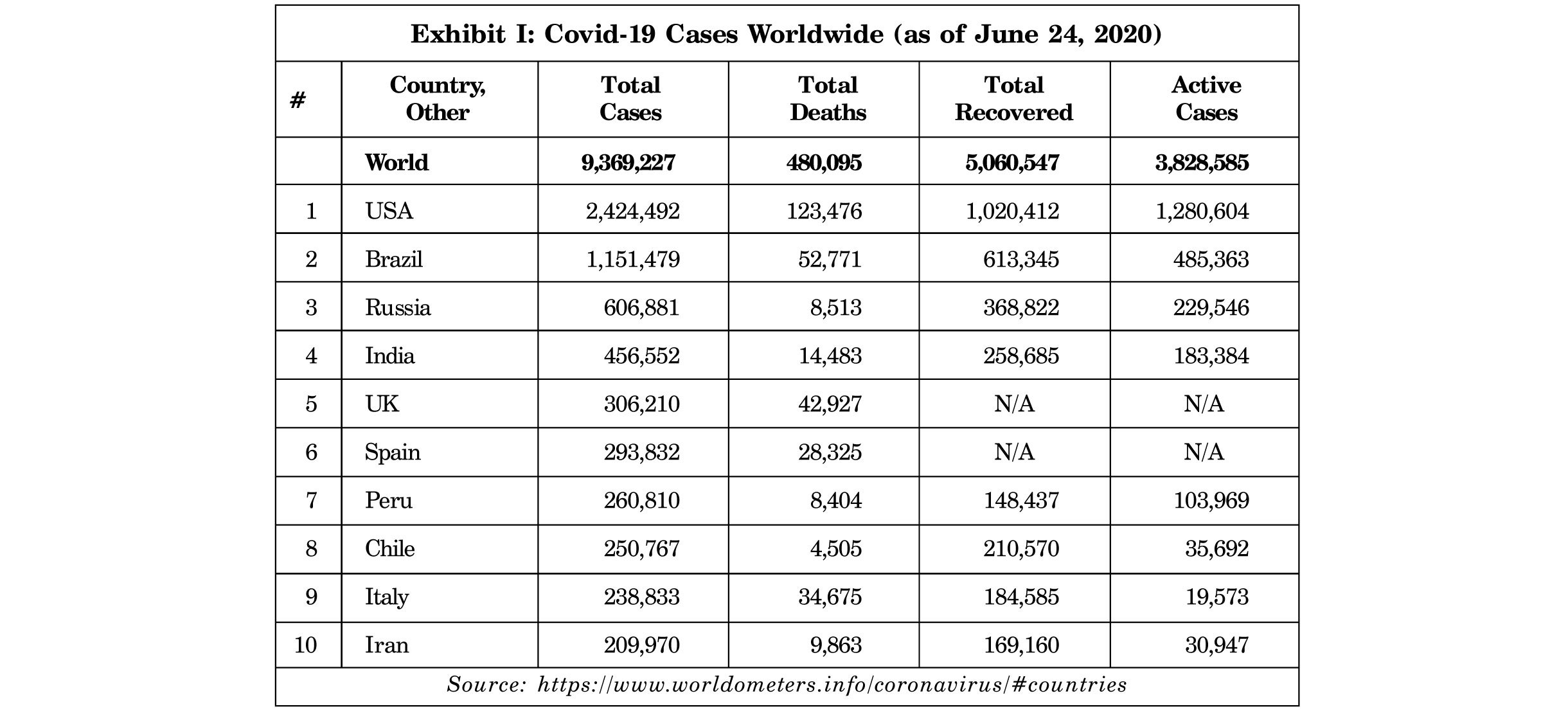
Taiwan?s Response to Covid-19
A study called ?Modelling the Spread of 2019-nCoV? conducted by Johns Hopkins University in January 2020 forecast that Taiwan would be one of the most at-importation risk areas outside of mainland China due to its geographic proximity and extensive trade links with China, the epicenter of the Covid-19 outbreak (See Exhibit II). In 2019, about 2.71 million visitors from the mainland traveled to Taiwan. With over 850,000 of its citizens residing and working in mainland China and given that the outbreak coincided with the Chinese New Year, one of the busiest travel times of the year, experts predicted that Taiwan would be heavily affected by Covid-19.
Taiwan was the hardest hit when SARS4 broke out in China in 2003. In 2004, the year after the SARS outbreak, the Taiwan government formulated policies and
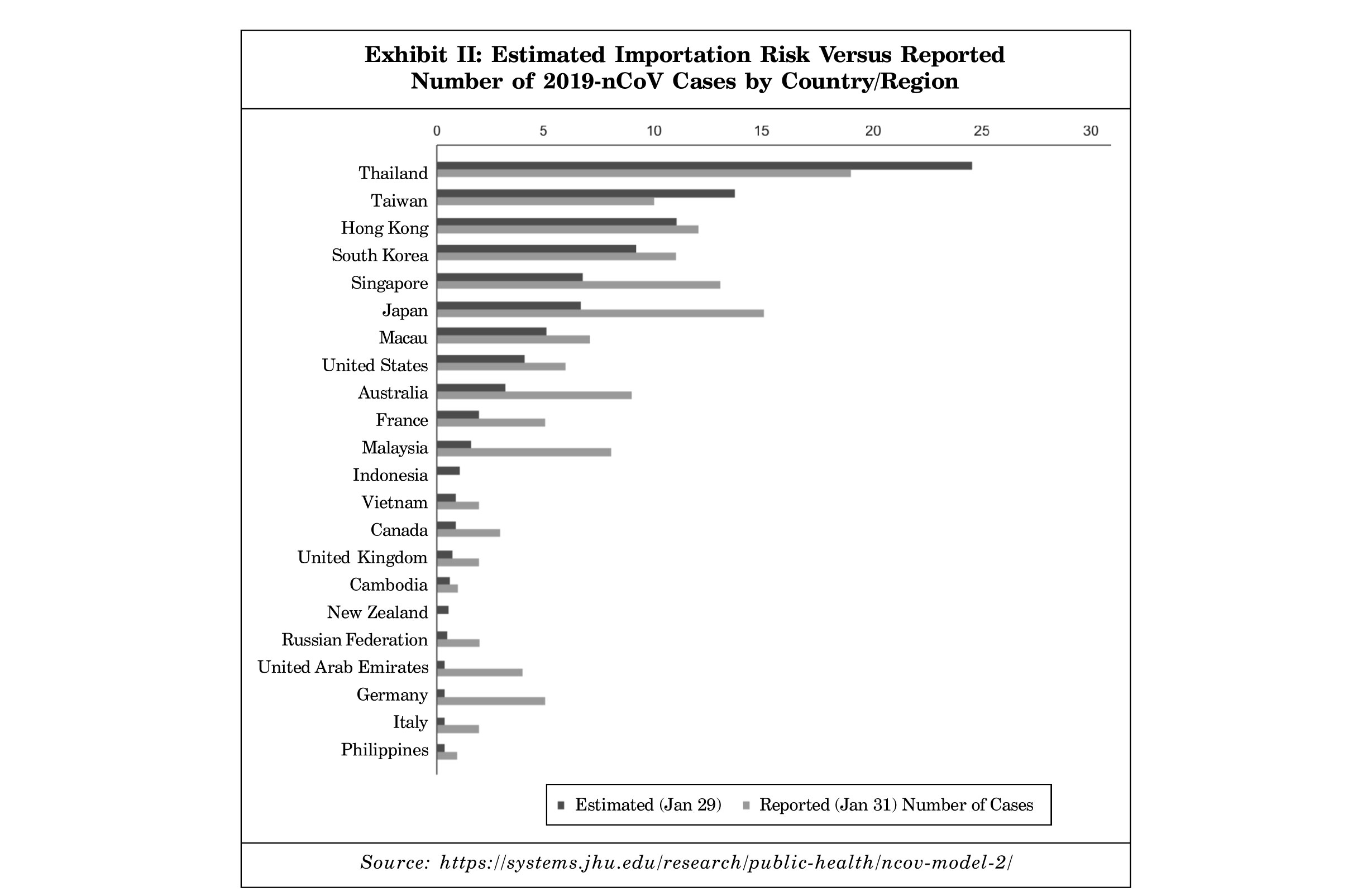
established institutions in order to empower experts during epidemics and improve its epidemic preparedness. For instance, the government established the National Health Command Center5 (NHCC), a disaster management and recovery center to addresses public health emergencies. The NHCC was placed under the Taiwan Centers for Disease Control6 (CDC) that in turn operated under the Ministry of Health and Welfare (MOHW).
On December 31, 2019, the same day that China notified the WHO of the outbreak of pneumonia of unknown cause in Wuhan, the Taiwanese government quickly reacted and came out with a four-pronged approach to combat the spread of the virus. This included early border control, proactive case finding and containment, resource allocation, and reassurance and education of the public.
According to analysts, the painful experience of the SARS outbreak had put the Taiwanese government on high alert early on in Taiwan with regard to the new outbreak and led them to take early measures against Covid-19. They said that Taiwan?s exclusion from WHO?s emergency meetings on the coronavirus, had denied the country crucial information regarding expert briefings and prevention measures. Hence, it had to be self-reliant and make decisions early on, independent of guidance from the WHO.
On January 20, 2020, while sporadic cases were reported from China, the CDC officially activated the Central Epidemic Command Center (CECC), a branch within the NHCC led by Vice-President Chen Chien-jen7 (Chen), himself an epidemiologist, and Shi-Chung Chen, Minister of Health and Welfare, to coordinate and lead the response to the virus. The CECC had three divisions: intelligence, operations, and logistics, each comprising targeted teams of officials and specialists from relevant ministries and agencies. Totally, there were nine teams across the three divisions. Significantly, CECC was activated before Taiwan had even recorded its first case. According to James C F Huang, Chairman of Taiwan External Trade Development Council, ?Many of our current officials, both in the CDC and other levels of government, lived through the SARS crisis and saw the problems it caused. That experience allowed us to move swiftly from the very first signs of a potential epidemic. But we also have the unique advantage of having many medical doctors in positions where they can shape policy and give recommendations [?.]. There were also a number of published research papers after the SARS outbreak, attempting to understand what had worked and what had not. Many of the quarantine procedures used in our hospitals now are a result of the studies conducted in 2004 and 2005.?vi
Within a span of just 5 weeks i.e., between January 20 and February 24, the CECC implemented a total of 124 measures including controlling both air and sea borders, identifying cases, quarantine of suspicious cases, managing resource allocation, daily press briefings, identifying false information, and formulating economic policies to relieve families and businesses.
On February 25, 2020, Taiwan passed a Special Act on Covid-19 Prevention, Relief, and Restoration as part of the government?s commitment to ensure public health while maintaining social and economic stability. Effective retrospectively from January 15, 2020 and lawful until June 30, 2021, the act included 18 articles providing compensation, subsidies and tax breaks for businesses, individuals, medical institutions, schools and other organizations affected by Covid-19. It also offered rewards for those who made substantial contributions to outbreak prevention and stipulated punishments for violating disease-related regulations such as breaking quarantine, hoarding essential materials and spreading disinformation. According to MOHW a special budget of NT$60 bn ($1.97 bn) was allocated for executing the act. President Tsai said that the legislation was a testament to the efficiency of Taiwan?s democratic system and smart government planning.vii
Early Border Control
Starting December 31, 2019, the CDC immediately ordered monitoring of passengers arriving on flights from Wuhan for fever and pneumonia before they deplaned. Within a couple of days, these measures were expanded to include fever screening and medical examination of suspected cases.
In early January 2020, many Taiwanese people and their families based in China were returning to celebrate the Lunar New Year. From early January 2020, the CDC started monitoring all individuals who had traveled to Wuhan in the previous 14 days and those who showed signs of fever or upper respiratory tract infections, and quarantined those who tested positive. On January 21, 2020, Taiwan reported its first confirmed case, a Taiwanese businessperson returning from Wuhan.
During the first phase of border control, Taiwan raised travel notices for affected areas of China in accordance with the severity of their respective outbreaks. Entry was prohibited for residents of Hubei Province from January 26, 2020, followed later by a complete ban on entry of residents of China, including Hong Kong and Macau, on February 11, 2020. On March 19, 2020, an entry ban was imposed on foreign nationals (exempting those holding a valid Resident Certificate or special entry permit). Travelers and people with temporary visas who were already in Taiwan had their visas extended. Taiwanese citizens were advised not to travel overseas, unless essential (See Exhibit III).
However, on January 31, 2020, Taiwan permitted the docking of the Diamond Princess8 cruise ship and allowed passengers to disembark in Keelung, near New Taipei City, before the ship left for Japan. The ship was subsequently found to have numerous confirmed infections onboard. This created temporary panic among the public with concerns about community spread. At that time, the government published the 50 locations that the cruise ship travelers could have visited and asked people who might have come into contact with the tour group to conduct symptom monitoring and self-quarantine if necessary. None were confirmed to have Covid-19 after 14 days had passed.
Isolation, Testing and Tracing
The country followed its own guidelines, deploying in-house capabilities and leveraging its Information and Communication Technology (ICT) expertise to tackle the crisis.
The Taiwanese government integrated big data and technology to monitor people with potential infection. In a single day?on January 27, 2020?officials integrated Taiwan?s National Health Insurance Administration (NHIA) database with its immigration and customs database to track the 14-day travel histories and symptoms of its citizens, nearly all of whom had an identifying National Health Insurance (NHI) card. All hospitals, clinics, and pharmacies were given access to this joint-database. By collating these databases, the administration was able to easily identify those with a history of travel to affected areas and monitor people with potential infection. Those identified as high risk were put under home quarantine and monitored electronically through mobile phones.
Taiwan restricted the entry of foreign travelers from the most affected regions, and those who were allowed to enter were tracked by officials using mobile technologies. On February 14, 2020, the Entry Quarantine System was launched at Taiwan airports wherein both Taiwanese and foreign travelers upon arrival were asked to scan a QR code that took them to an online health declaration form where they had to provide
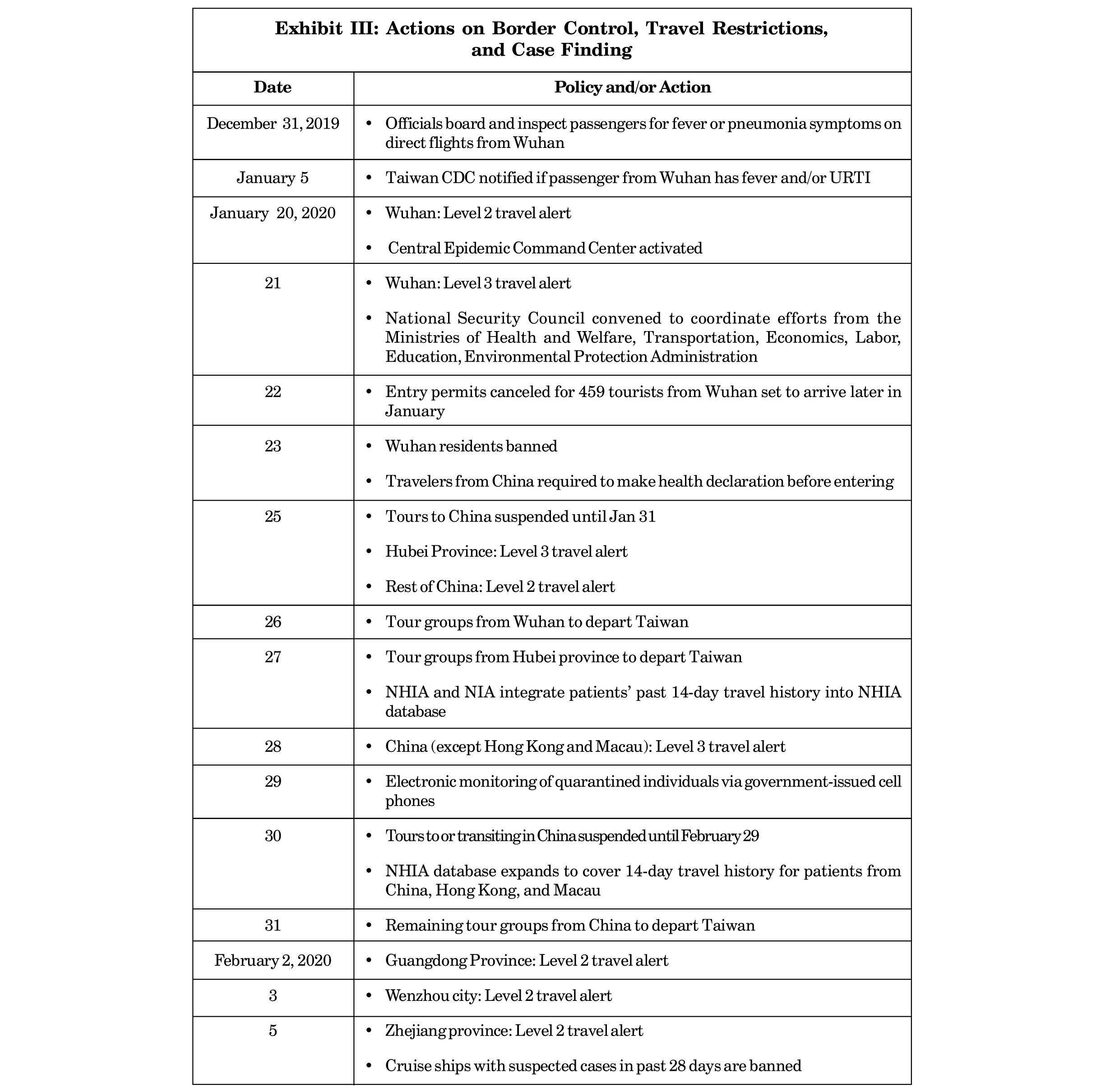
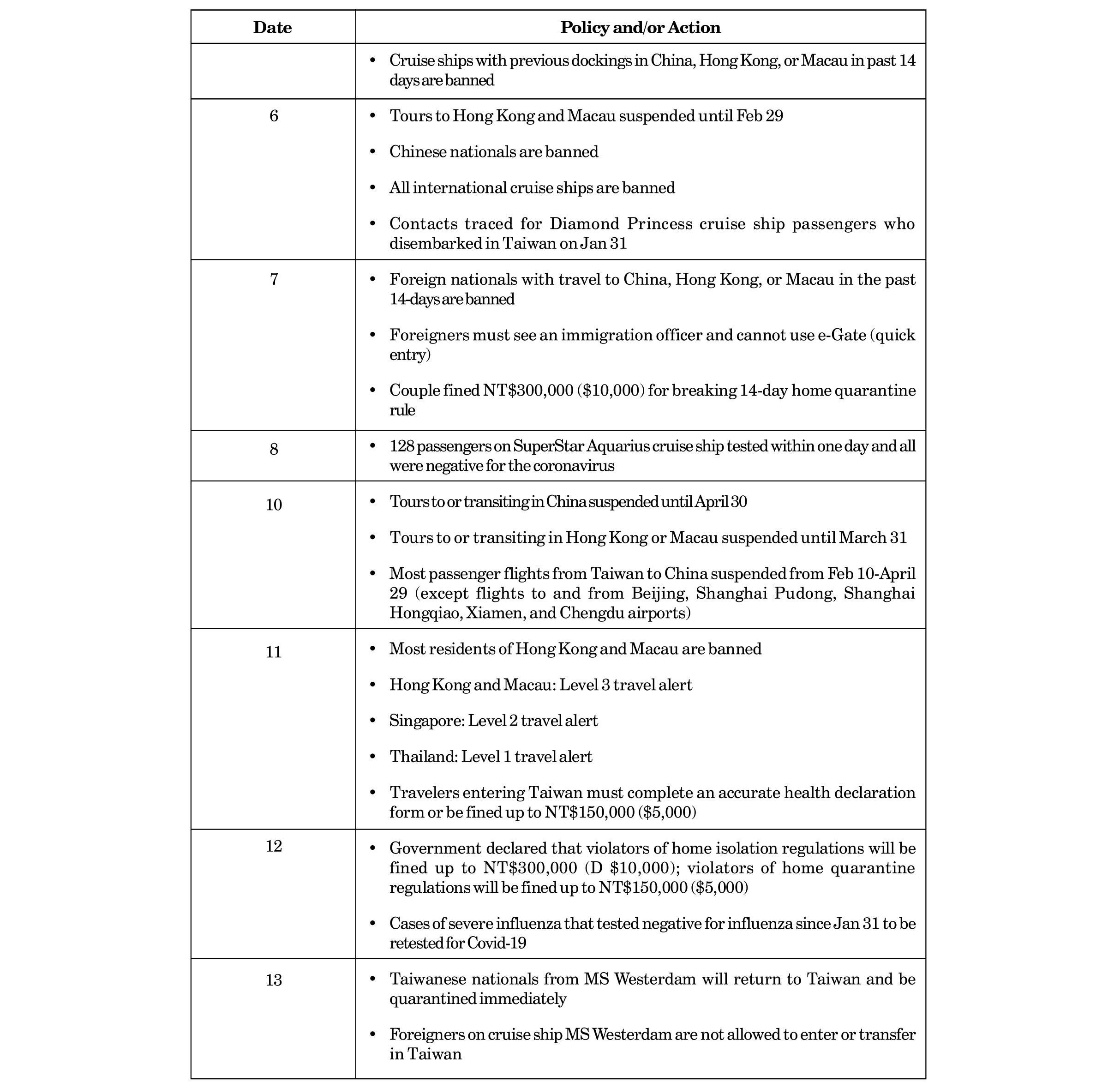
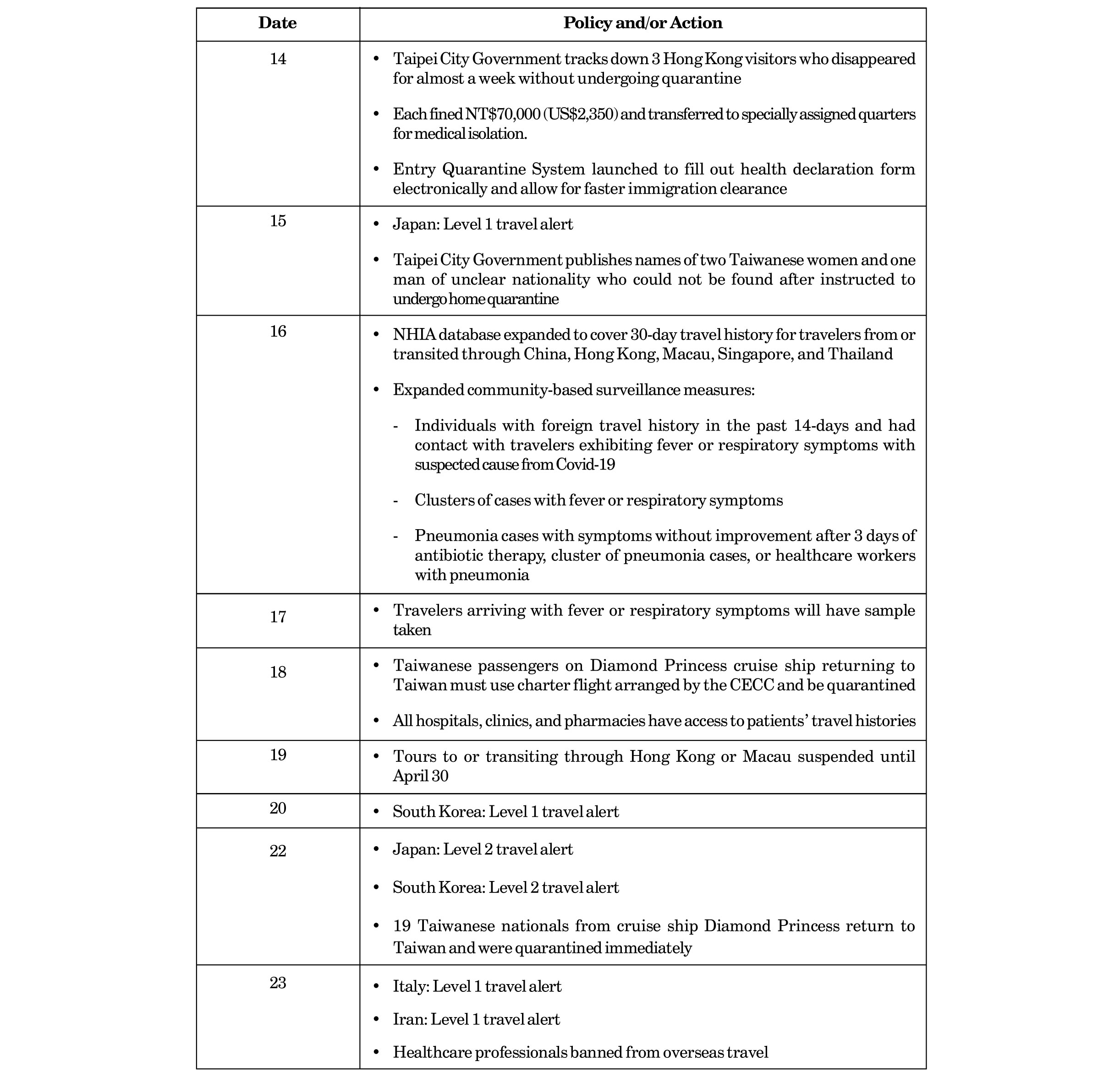
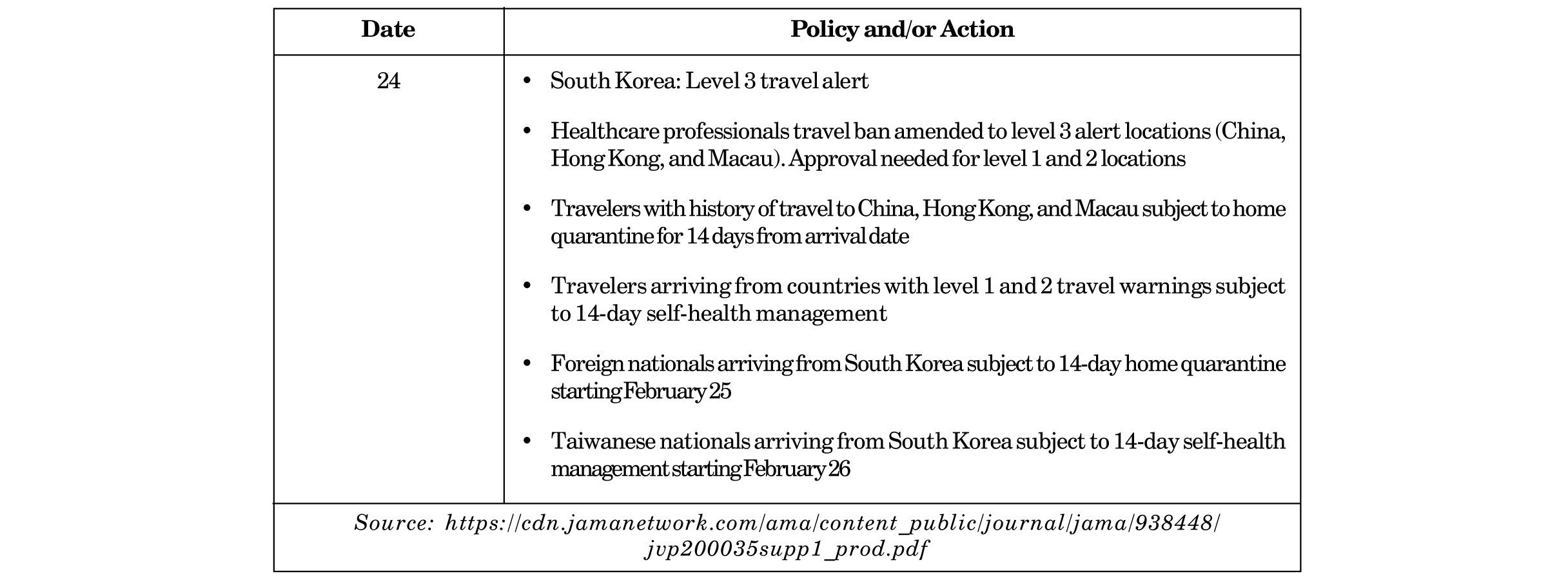
contact information. A mobile health declaration pass was then sent via SMS to their phones using a local telecom operator, which allowed faster immigration clearance for those with minimal risk. Those with higher risk were asked to undergo two weeks of home quarantine and tracked through government-issued mobile phones and monitored through calls and visits to ensure that they did not break the quarantine rules.
The quarantine monitoring system in Taiwan was called a ?digital fence,? whereby anyone required to undergo home quarantine had his/her location monitored through cellular signals from their phones (See Exhibit IV). The system monitored phone signals to alert police and local officials if those under home quarantine moved away from their address or turned off their phones. Working with the country?s five major telecoms companies, the system tracked the quarantined individual by triangulating the location of their phone relative to nearby cell towers. Venturing too far from home would trigger the alert system, and calls and messages would be sent to the individuals to ascertain their whereabouts. Anyone caught breaching their quarantine could be fined up to NT$91 mn ($33,000). And if someone left their phone at home and ventured out, the Taiwanese authorities deployed the M-Police system, which gave police officers cloud-based access to a database of individuals under quarantine orders. The police then searched popular gathering places to check the identities of patrons to see if anyone matched people on the list of quarantined individuals. Reportedly, Taiwan was one of the first countries to use mobile phone location as a quarantine compliance mechanism. The digital fence was created within a 72-hour period. According to Taiwan?s digital minister Audrey Tang (Tang), a key figure in Taiwan?s national epidemic prevention team, ?Governments around the world are combining technology and human efforts to enforce quarantines that require people who have been exposed to the virus to stay in their homes, but Taiwan?s system, the Digital Fence, is believed to be the first to use mobile phone tracking for that purpose. The use of the Digital Fence system is a crucial part of the current epidemic prevention measures.?viii
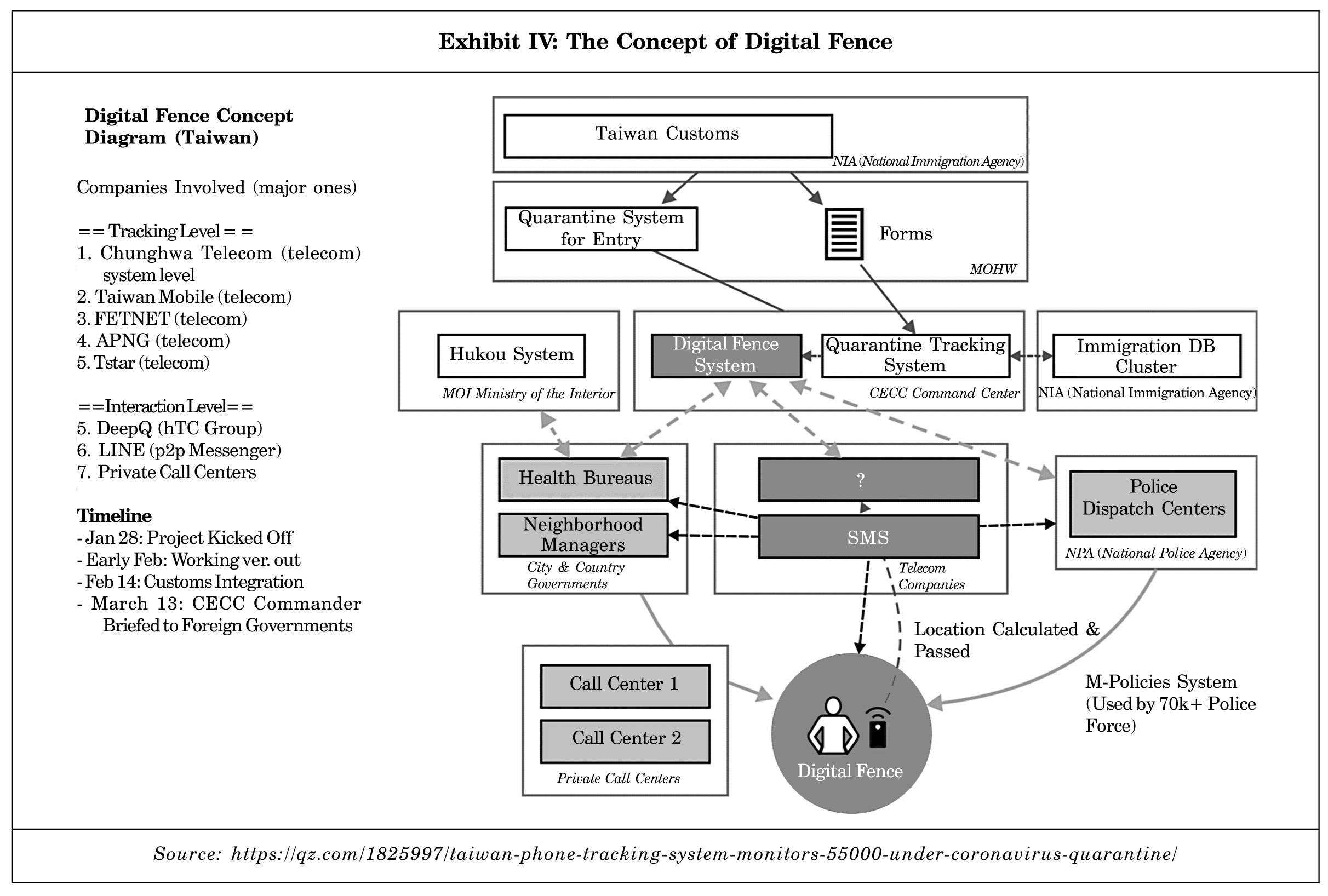
The quarantine tracking system was also used to provide care and support to quarantined or isolated persons. Authorities would either regularly text or call quarantined persons multiple times a day to ensure they were staying inside. If someone in quarantine failed to answer a check-in call or text, the chances were that police would be at their door in an hour. At the same time, as an incentive, the government paid NT$1,000 per day, (about $450 for 14 days) for those undergoing quarantine. It also provided a series of care and supportive services to persons under home quarantine including a 24-hour, seven-day hotline for consultation, family visit, meal delivery, garbage collection, support for settlement, as well as healthcare arrangement. ?They incentivized people to be truthful on their health declaration forms. If you are placed in the high-risk group, the government will help you get care. If you get sick by yourself, you?ll have to wander around the hospital trying to get help,?ix said C Jason Wang (Wang), Director of the Center for Policy, Outcomes and Prevention at Stanford University.
Taiwan conducted extensive testing for the virus and retested people with higher risk who had already tested negative. Ever since the outbreak began in the country, Taiwan had conducted 75,642 tests (as of June 2020). In April 2020, NHRI President Liang Kung-yee announced government investment of NT$2.16 bn ($71.7 mn) for the testing, treatment, prevention, and research of Covid-19.
On March 12, 2020, the CECC designated 167 medical facilities for virus testing and 50 for the care of severe cases. This arrangement for community hospitals and major medical centers to share the workload of providing test services effectively distributed patients and ensured the stability of Taiwan?s medical system. These hospitals and clinics were required to set up special wards or areas and all visitors had to pass through a temperature checkpoint. Medical facilities made masks mandatory for people entering their premises, limited the number of people allowed to accompany a patient, and banned visits to inpatients, in order to minimize the risk of nosocomial infection.
Taiwan also carried out door-to-door check-ins. Households were grouped into wards, or sections, and a chief was named for each ward. The public was educated about proper procedures in maintaining good hygiene and mandatory temperature checks were established in all schools as well as many other public spaces. Hospitals also set up temperature check points and disinfectant stations and established special protocols for handling Covid-19 cases, in order to prevent infections within health clinics. The government addressed the issue of disease stigma and compassion for those affected by providing food, frequent health checks, and encouragement for those under quarantine. Taiwan did not shut down businesses or impose lockdowns to stop the spread of the virus.
Taiwan encouraged people to use face masks in crowded areas at the early stages. On April 5, 2020, the government announced that people failing to wear a mask in the public transport system everywhere in Taiwan would be fined about NT$15,000. CECC announced social distancing measures on April 1, 2020. People were requested to maintain a personal distance of 1.5 meters indoors and 1 meter outdoors. Businesses which could not maintain social distancing among customers were asked to close down until further notice.
Mask Rationing System
From January 24, 2020, the Taiwanese government imposed a ban on the export of face masks in order to ensure an adequate supply for its citizens. The government requisitioned a total of 73 local manufacturing companies to form a national face mask production team that expanded 92 production lines for manufacturing face masks. Reportedly the government invested NT$200 mn ($6.66 mn) to purchase equipment and add production lines. The military was also involved in ramping up production. More than 1,800 army reserve troops aided in mask production across 28 manufacturers. As of April 16, the average daily production of surgical face masks increased from 1.9 million in January to 16 million in April 2020.
The sale of masks was also strictly controlled to make sure every individual had access to them and nobody would be able to buy and hoard masks for private use. A standard price was also set for each mask to ensure masks were readily available to the general public and to prevent profiteering. At the beginning of February 2020, CECC launched a name-based mask rationing system for mask purchases at NHI-contracted pharmacies and local public health agencies. According to the system, every citizen could buy three masks per week. This was then raised to 9 every two weeks, and finally an online ordering system was launched. In order to avoid crowds around stores, those whose NHI cards ended in odd numbers were allowed to purchase masks on Mondays, Wednesdays, and Fridays, while those whose cards ended with even numbers could buy masks on Tuesdays, Thursdays, and Saturdays. Both were allowed to make purchases on Sundays. According to MOHW, people who attempted to hoard equipment or medical supplies deemed necessary for disease prevention would face a prison term of up to five years and a fine of up to NT$5 mn.
After the government announced the rationing of face masks, Tang collaborated with a community of social innovators through the virtual Taiwan or vTaiwan10 platform to develop an online mask supply and demand information platform wherein citizens were guided through maps, apps, chatbots, and voice assistance to procure the masks from nearby pharmacies, public health centers, or convenience stores using the NHI card. The platform contained over a hundred apps and other digital tools that provided real-time information to help citizens search for mask inventory levels and then purchase masks at pharmacies through the name-based rationing system across Taiwan. In addition to that, the government partnered with major convenience stores to implement an online ordering mechanism at the ?eMask Ordering System? for all residents, with delivery and pick-up at convenience stores. The mechanism allowed people to order from the website using their NHI cards.
Transparent and Open Communication
CECC organized daily press briefings led by the health minister that were live streamed to update the public about the latest developments concerning Covid-19, as well as new disease prevention measures. These containment measures were promoted through both traditional media outlets, such as television and broadcast media, and social networks such as Facebook, Twitter, and Taiwan CDC?s official LINE account. According to analysts, a key contributor to the success of the government?s disease-fighting efforts was keeping the public fully abreast of developments at home and abroad, with health officials offering daily press briefings and updates through social media channels. The government also engaged third-party independent fact-checking platforms such as Taiwan FactCheck Center (TFC) and MyGoPen. These institutions checked disinformation on the epidemic, which mostly circulated online, while broadcasting the right information to the public. CDC announced that individuals spreading fake news or disinformation about Covid-19 could face a maximum prison term of three years and a fine of NT$3 mn ($100,000). ?Taiwan?s success is no coincidence. The most fundamental element of the Taiwan model is transparency, transparency between the authorities and the public in Taiwan and transparency between Taiwan and the international community. The Taiwan model, which is one of the most effective in the world, is the product of a democratic system,?x noted President Tsai.
Taiwan?s digital ministry developed viral memes and used animal mascots as part of its campaign to educate public about the outbreak and prevent the spread of infections (See Exhibit V). Images of cute animals featured in daily social media updates from government to ease public anxiety and inform them about safety measures. MOHW created a cartoon ?spokesdog??a shiba inu11 called Zongchai?to provide the Taiwanese people with accurate information and timely updates about prevention and containment measures. For instance, in a Valentine?s Day message, Zongchai offered practical advice for dating during an outbreak, from regular hand washing to staying sober.xi The cartoon spokesdog proved to be a hit, with hashtags of his name going viral and posts shared multiple times. Other mascots, such as a pigeon in a face mask informed citizen about travel restrictions.
?Taiwan Can Help? Campaign
While prioritizing the needs of the Taiwanese at home, the government extended humanitarian assistance and used its excess capacity to contribute to international epidemic prevention efforts. The country offered medical assistance to countries struggling to contain the virus through the campaign ?Taiwan can Help? by donating masks and other medical equipment.
As part of the campaign, Taiwan donated 10 million masks to the US, Italy, Spain, and nine other European countries, as well as smaller nations that had diplomatic ties with the island such as the Caribbean, the Pacific, and Africa. In its second round of international humanitarian assistance, Taiwan donated another 7 million masks. Taiwanese leaders, including President Tsai and the Foreign Ministry, promoted the hashtag #TaiwanCanHelp on Twitter. Calling Taiwan?s openness and generosity in the battle against coronavirus a model for the world, US Secretary of State Mike Pompeo said, ?During tough times, real friends stick together.?xii
Despite not being a member of the WHO, Taiwan signed agreements with countries which were seeking help in battling the coronavirus. It planned to collaborate with the US and some European countries to develop rapid diagnostic antivirals and vaccine. In March 2020, the US and Taiwan issued a joint statement on a partnership to combat Covid-19, including the development of test kits, vaccines, medication, and contact tracing techniques and organizing of joint conferences with scientists and experts. Academia Sinica, an academic research institution in Taiwan, engaged in talks with officials from the European Union to explore cooperation on the development of rapid testing kits and vaccines. ?It?s a rare opportunity for Taiwan. Countries rarely pay attention to Taiwan and why it?s successful. Why shouldn?t Taiwan showcase its expertise??xiii said Bonnie Glaser, Senior Adviser and Director, China Power Project at Center for Strategic and International Studies (CSIS), a US-based think tank.
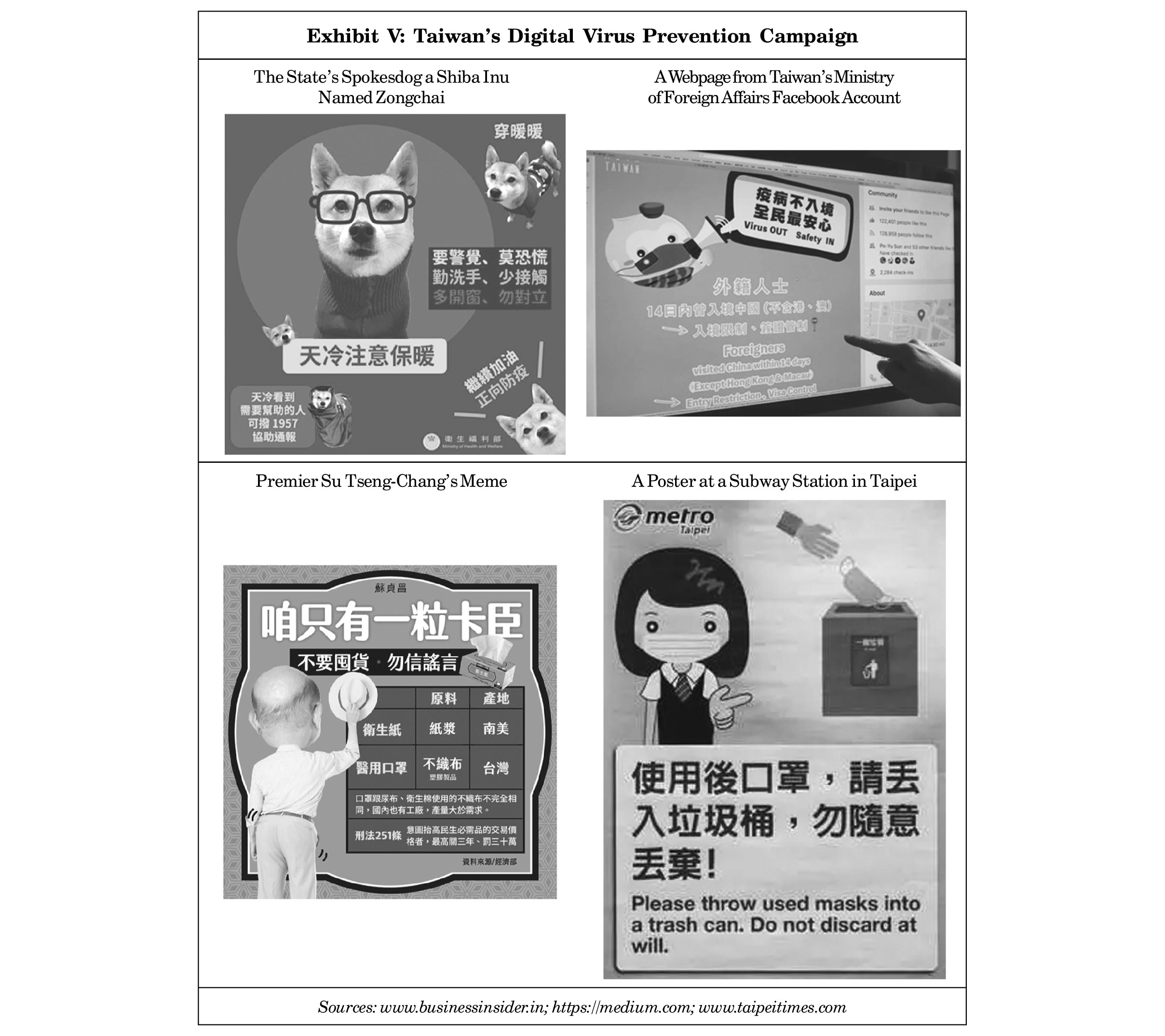
Results
Even as the disease continued to wreak havoc across the globe, Taiwan was able to successfully reduce the number of infections and minimize deaths. As of May 30 2020, it had about 440 cases and 7 deaths with a mortality rate of 0.25 per million people (See Exhibits VI and VII). Taiwan experienced a surge in cases starting March 12, 2020, (49 cases) which increased to about 395 by April 15, 2020. However, within a month it managed to flatten the infection curve and bring the contagion under control by reducing the number of new cases per day to fewer than 10 by April 12, 2020, compared to 26 new cases a day on March 26, 2020. Experts said that Taiwan had managed to maintain the lowest infection rate per million for the longest period in the world (See Exhibit VIII). The island managed this without ever announcing a lockdown or significantly disrupting domestic economic and social life. According to Wang, Taiwan was able to contain the spread of the virus largely due to the effective use of technology and a robust pandemic strategy which included early mobilization of specific strategies and plans implemented during the SARS outbreak in 2003.
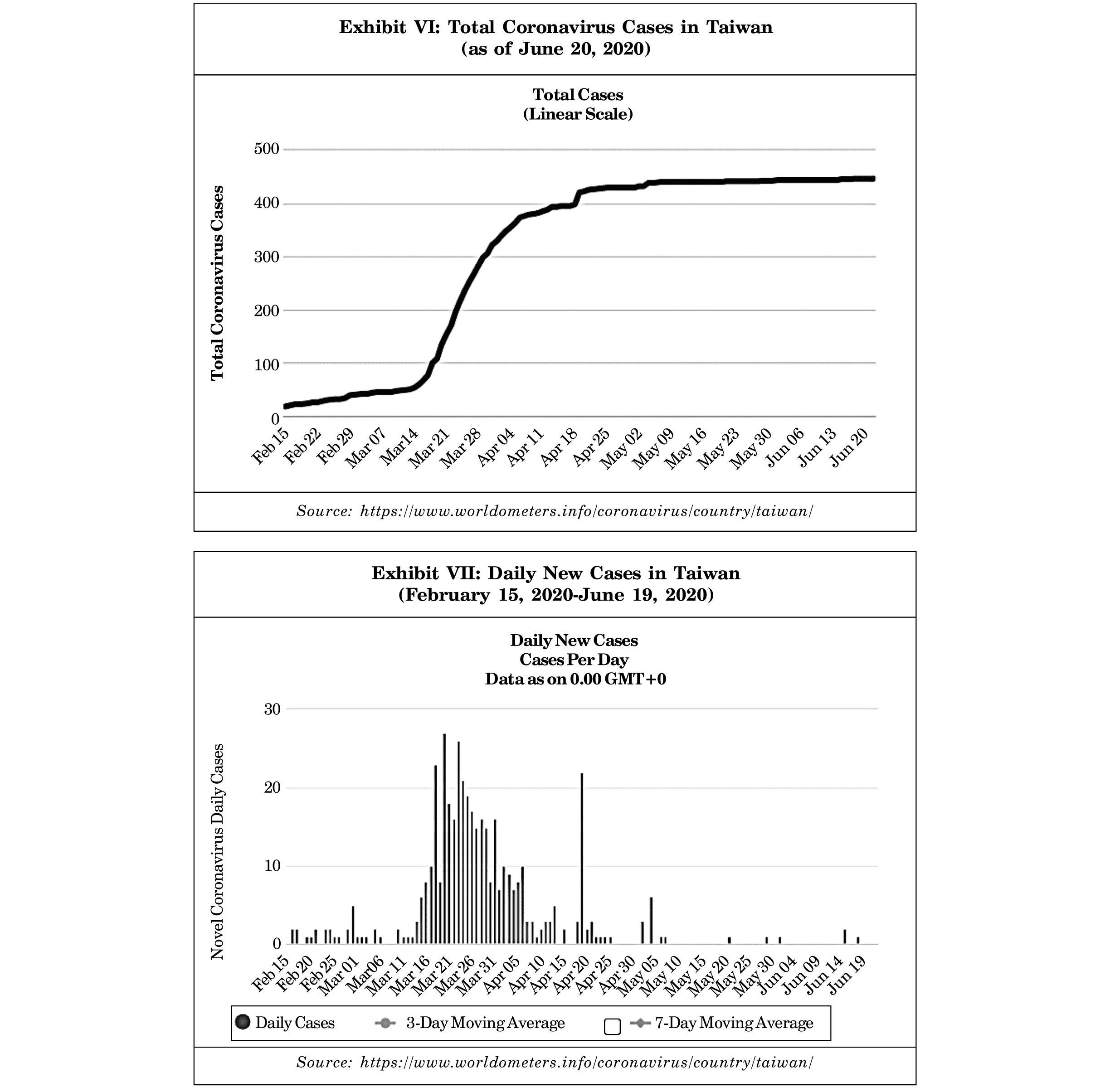
The economic impact of the outbreak was relatively milder on Taiwan and the country?s export-dependent economy kept expanding (See Exhibit IX). In March 2020, Taiwan witnessed a surge in export orders. Export orders were up, with a 4.3% increase year-on-year. The demand for electronic goods surged by 23.8% in March 2020 and electrical machinery saw an increase of 8.6%. According to industry observers, Taiwan?s successful response to the Covid-19 pandemic was likely to boost its retail and hotel segments. Taiwan?s hotel and retail segments received $114.3 mn in investment as of April 2020, more than a fifth of the $536.3 mn in investment they recorded in the first half of the previous year, according to data from Real Capital Analytics. According to Richard Yue, CEO of investment management firm ARCH Capital Management, ?Retail in Taiwan has been stable and, in fact, quite resilient during this period because they have always relied on domestic demand versus demand derived from tourism.? ?Social distancing has had some impact on foot traffic, but the overall effect on revenue has been minor compared to what many other countries are experiencing,? he said.xiv

Economists and financial services agencies such as S&P Global Ratings revised Taiwan?s GDP for 2020, but by a smaller margin than any other industrialized country. S&P Global Ratings reaffirmed its long-term AA-rating for Taiwan, citing its highly competitive electronics manufacturing sector as a likely driver for a strong economic recovery post the outbreak.
On March 12, 2020, President Tsai convened a high-level national security meeting and announced proactive measures to boost Taiwan?s economic strength. The government allocated a budget of NT$1,050 bn for epidemic control, financial relief, and economic vitality and for maintaining the stability of the foreign exchange market and momentum of the stock market.
The Road Ahead
Despite its success in combatting Covid 19, Taiwan remained excluded from the WHO and shut out of global health discussions. According to some Taiwanese officials, their exclusion from the WHO was preventing the island from playing its full part in the global response. They said that with more access to the WHO, Taiwan would be able to offer more help in the global fight against Covid-19. ?We want to help?to send out our great doctors, our great researchers, our great nurses?and to share our knowledge and experience with countries that need it. We want to be a good global citizen and make our contribution, but right now we are unable to,?xv said Chen.
However, Taiwan?s success in fighting the coronavirus had bolstered its global image and its long-running campaign for a membership in the WHO was getting renewed support from multiple countries. Nations such as the US, the UK, Japan, EU, and Australia were among those that had joined the call for Taiwan to be given access to the WHO. On March 26, 2020, US President Donald Trump signed the Taiwan Allies International Protection and Enhancement Initiative (TAIPEI) Act of 2019 into law. The new law intended to strengthen Taiwan?s diplomatic relations with other countries in the Indo-Pacific region and reduce the US?s engagement with nations whose actions served to undermine the security or prosperity of Taiwan.
According to experts, despite its exclusion from the WHO, Taiwan had become a role model for the world on how to fight the coronavirus. Given its outstanding medical researchers and highly efficient national healthcare system, Taiwan was well-positioned to play a significant part in promoting public health internationally, especially during such times of emergency and had much to offer to control the spread of the pandemic. ?Taiwan?s trajectories and execution strategies in assessing Covid-19 and quick actions in preventing a large-scale epidemic may be instructive for other countries as the virus continue to threaten global health and economies,?xvi noted Hithaishi Bhaskar, Assistant Manager at Biospectrum Asia, a B2B media platform for the healthcare and bioscience industry in the Asia Pacific region. However, going forward, it remained to be seen whether the intensive nature of Taiwan?s pandemic prevention policies could be maintained until the end of the contagion and continue to be well received by its citizens.
End Notes
- C Jason Wang, ?Response to COVID-19 in Taiwan Big Data Analytics, New Technology, and Proactive Testing,? https://jamanetwork.com, March 3, 2020.
- Stacy Chen, ?Taiwan Sets Example for World on How to Fight Coronavirus,? https://abcnews.go.com, March 13, 2020.
- ?President of Taiwan: How My Country Prevented a Major Outbreak of COVID-19,? https://time.com, April 16, 2020.
- ?Why is Taiwan Excluded from the WHO?? https://www.bangkokpost.com, May 16, 2020.
- Mahesh Kumar Kamtam, ?Explained: The Conflict Between the WHO and Taiwan,? www.wionews.com, April 20, 2020.
- Navtan Kumar, ??Swift Action Let Taiwan Manage Covid Crisis?,? www.sundayguardianlive.com, April 25, 2020.
- ?Taiwan Passes COVID-19 Relief Act,? https://taiwantoday.tw, February 26, 2020.
- https://www.frstrategie.org/sites/default/files/documents/publications/autres/2020/Interview%20Audrey%20 Tang.pdf
- Emily Waltz, ?Big Data Helps Taiwan Fight Coronavirus,? https://spectrum.ieee.org, March 12, 2020.
- ?President of Taiwan: How My Country Prevented a Major Outbreak of COVID-19,? https://time.com, April 16, 2020.
- Amber Wang, ?Virus Outbreak: Mascots Embraced for Virus Prevention Campaign,? www.taipeitimes.com, February 18, 2020.
- Nectar Gan and Brad Lendon, ?Taiwan?s Success in Fighting Coronavirus has Bolstered Its Global Standing. This has Infuriated Beijing,? www.news-daily.com, May 15, 2020.
- Nick Aspinwall and Emily Rauhala, ?Taiwan Beat Covid-19 and Won Friends. At the WHO, It?s Still Fighting for a Seat at the Table,? www.washingtonpost.com, March 15, 2020.
- Cheryl Arcibal, ?Taiwan?s Successful Coronavirus Response is Likely to Boost Its Retail, Hotel Segments,? www.scmp.com, April 21, 2020.
- James Griffiths, ?Taiwan?s Coronavirus Response is Among the Best Globally,? https://edition.cnn.com, April 5, 2020.
- Hithaisi Bhaskar, ?Taiwan?s Success Story in Combatting Covid-19,? www.magzter.com, May 2020.
- Johns Hopkins University is one of the leading research universities in the US, discovering and sharing knowledge globally since 1876.
- Founded in 1948, the World Health Organization (WHO) is the United Nations? specialized agency for Health responsible for providing leadership on global health matters, shaping the health research agenda, setting norms and standards, providing technical support to countries, and monitoring and assessing health trends.
- China demands a commitment to the ?One-China Principle? as a precondition for Taiwan?s entry into any bilateral and multilateral relations, recognizing that there is only one China and that Taiwan is an integral part of it.
- Severe Acute Respiratory Syndrome (SARS) is a viral respiratory illness caused by a coronavirus called SARS-associated coronavirus (SARS-CoV). The outbreak was first reported in Foshan, Guangdong, China, in February 2003. Thereafter, the illness spread to about 24 countries in North America, South America, Europe, and Asia. The disease infected 346 people in Taiwan and caused 73 deaths. Taiwan then had the highest mortality rate in the world.
- The NHCC operates as a unified central command system among central, regional, and local authorities composing the CECC, the Biological Pathogen Disaster Command Center, the Counter-Bioterrorism Command Center, and the Central Medical Emergency Operations Center. The dedicated workforce implements optimized surveillance systems, strengthens border controls and quarantine rules, and enhances contagious diseases screening.
- The Taiwan Centers for Disease Control (CDC) is an agency of Taiwan Ministry of Health and Welfare responsible for combatting the threat of communicable diseases.
- Taiwan?s Vice-President, Chen Chien-jen is a Johns Hopkins University trained epidemiologist and a public health expert. He became a national hero for his role as health minister during the SARS outbreak in 2003 and the H1N1 outbreak in 2009. He has been instrumental in helping the Taiwan government move forward in the face of Covid-19, guided by his own training, and his experience as Minister of the Department of Health during the SARS outbreak.
- British-registered Diamond Princess was the first cruise ship to have a major outbreak on board, with the ship quarantined at Yokohama from February 4, 2020, for approximately one month. Over 700 people became infected, and 14 people died.
- The New Taiwan dollar (symbol: NT$) is the official currency of Taiwan. As on June 2020, one Taiwanese dollar was approximately equal 0.0337571 $.
- Started in 2014, virtual Taiwan or vTaiwan is an open source technology platform that brings together representatives of the public, private and social sectors to discuss policy solutions to problems related to the digital economy.
- The Shiba Inu is a Japanese breed of hunting dog.
